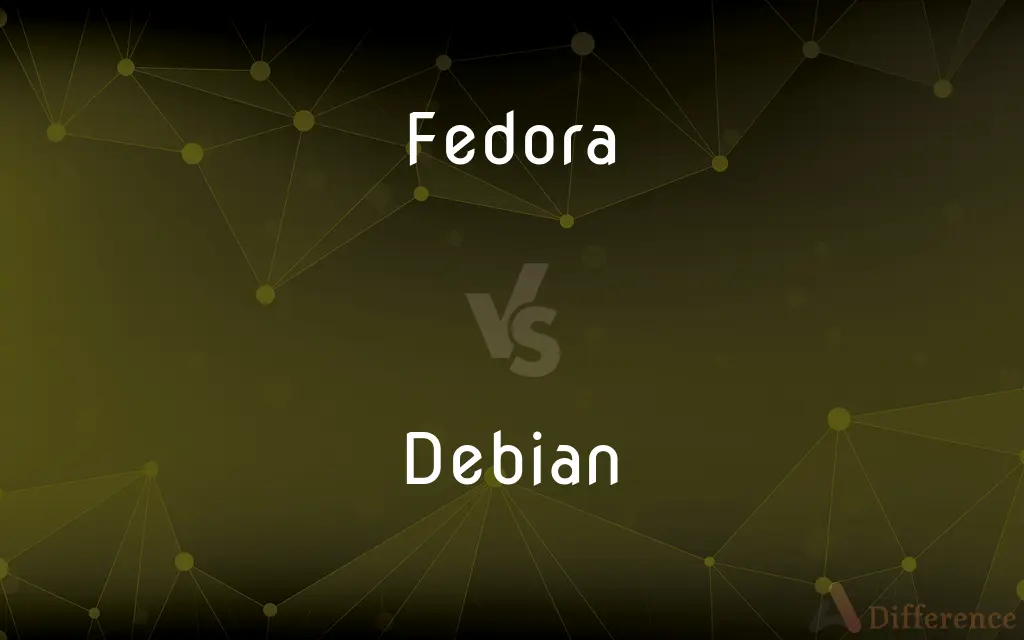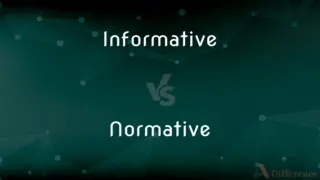Fedora vs. Debian — What's the Difference?
By Maham Liaqat & Fiza Rafique — Updated on March 26, 2024
Fedora is known for cutting-edge features, while Debian prioritizes stability and supports numerous architectures.

Difference Between Fedora and Debian
Table of Contents
ADVERTISEMENT
Key Differences
Fedora is a Linux distribution developed by the Fedora Project and sponsored by Red Hat. It is known for incorporating the latest software technologies and being a testbed for features that may later be included in Red Hat Enterprise Linux (RHEL). Fedora aims to provide a free and open-source software stack that is updated frequently, making it appealing for those who want the latest advancements in Linux operating systems. Debian, on the other hand, is one of the oldest and most stable Linux distributions, maintained by a community of volunteers. Debian focuses on stability and reliability, making it a preferred choice for servers and long-term deployments. It supports a wide range of computer architectures, from ARM to x86, and provides access to over 59,000 software packages, making it one of the most versatile Linux distributions available.
While Fedora releases a new version approximately every six months and supports each release for about 13 months, Debian's release cycle is less frequent, with major stable releases appearing every two to three years. This longer cycle contributes to Debian's reputation for stability, as each release undergoes extensive testing.
Fedora uses the RPM package management system with the DNF package manager, which is known for its performance and user-friendliness. Debian uses the DEB package format with the APT package manager, renowned for its reliability and efficiency in handling package dependencies.
The choice between Fedora and Debian often comes down to the user's needs for cutting-edge features versus long-term stability. Fedora is suitable for those who prefer the latest software and are willing to tolerate some instability, while Debian is better for applications where reliability and broad architecture support are critical.
Comparison Chart
Focus
Cutting-edge technology and innovation
Stability and support for numerous architectures
ADVERTISEMENT
Release Cycle
Approximately every 6 months
Every 2-3 years for stable releases
Support Duration
About 13 months per release
Long-term; until the next stable release plus a year for transition
Package Management
RPM with DNF
DEB with APT
Ideal Use Case
Latest software and development
Servers, stable and long-term deployments
Community
Sponsored by Red Hat, community-driven
Purely community-driven, volunteer-based
Software Availability
Extensive, with a focus on freshness
Extremely extensive, with a focus on stability
Compare with Definitions
Fedora
Developed and sponsored by Red Hat.
Fedora serves as the upstream source for Red Hat Enterprise Linux.
Debian
Maintained by a community of volunteers.
Debian's development process is driven by the needs and contributions of its users.
Fedora
Uses RPM package format.
Installing software on Fedora can be done using the dnf install command.
Debian
A universally usable Linux distribution, known for its stability and reliability.
Debian is a popular choice for web servers due to its robustness.
Fedora
Known for rapid updates and releases.
Fedora's use of the latest GNOME desktop environment offers users new features faster.
Debian
Uses DEB package format.
Software installation on Debian systems is typically handled with the apt-get install command.
Fedora
A Linux distribution that offers the latest in free and open-source software.
Fedora Workstation is popular among software developers for its cutting-edge tools.
Debian
Supports a wide range of architectures.
Debian can be installed on anything from a Raspberry Pi to a mainframe.
Fedora
Focuses on innovation.
Fedora often includes experimental features not yet available in other distributions.
Debian
Emphasizes free software.
Debian provides one of the largest repositories of free software available.
Fedora
A fedora is a hat with a soft brim and indented crown. It is typically creased lengthwise down the crown and "pinched" near the front on both sides.
Debian
Debian (), also known as Debian GNU/Linux, is a Linux distribution composed of free and open-source software, developed by the community-supported Debian Project, which was established by Ian Murdock on August 16, 1993. The first version of Debian (0.01) was released on September 15, 1993, and its first stable version (1.1) was released on June 17, 1996.
Fedora
A soft felt hat with a fairly low crown creased lengthwise and a brim that can be turned up or down.
Fedora
A felt hat with a fairly low, creased crown with a brim that can be turned up or down.
Fedora
A soft felt hat with a crown creased lengthwise.
Fedora
Felt hat with a creased crown
Common Curiosities
How often do I need to upgrade Fedora compared to Debian?
Fedora requires more frequent upgrades (approximately every 6 months) compared to Debian's stable releases every 2-3 years.
Which has a larger software repository?
Debian has one of the largest software repositories available, with over 59,000 packages, catering to stability and variety.
What is the main difference between Fedora and Debian?
The main difference lies in their focus: Fedora emphasizes the latest software and innovation, while Debian prioritizes stability and supports a broad range of architectures.
Which distribution is better for servers?
Debian is often considered better for servers due to its stability and long-term support.
Is Fedora suitable for beginners?
Fedora is user-friendly and suitable for beginners interested in learning about the latest Linux technologies, but its frequent updates may require a bit more maintenance.
Do Fedora and Debian use the same package manager?
No, Fedora uses the DNF package manager with RPM packages, while Debian uses the APT package manager with DEB packages.
Which distribution is more experimental?
Fedora is more experimental, often incorporating new features and technologies before they become standard in other distributions.
Which is better for a software developer?
Fedora might be preferable for developers who need the latest development tools and environments, while Debian's stability is beneficial for production environments.
Can I use both for desktop computing?
Yes, both Fedora and Debian can be used for desktop computing, but your choice might depend on whether you prefer the latest software or a more stable system.
How does community support compare between the two?
Both distributions have strong community support, but Debian's community is entirely volunteer-driven, while Fedora is sponsored by Red Hat but also relies on community contributions.
Share Your Discovery

Previous Comparison
Armature vs. Rotor
Next Comparison
Informative vs. NormativeAuthor Spotlight
Written by
Maham LiaqatCo-written by
Fiza RafiqueFiza Rafique is a skilled content writer at AskDifference.com, where she meticulously refines and enhances written pieces. Drawing from her vast editorial expertise, Fiza ensures clarity, accuracy, and precision in every article. Passionate about language, she continually seeks to elevate the quality of content for readers worldwide.
















































